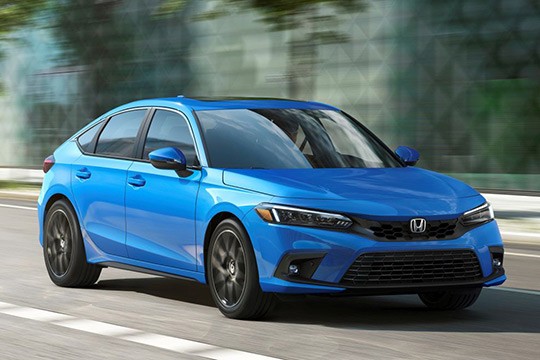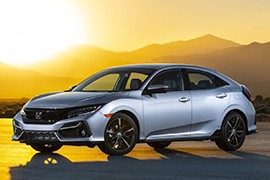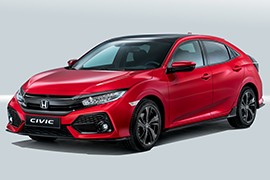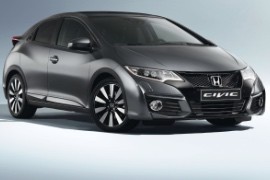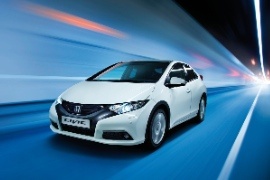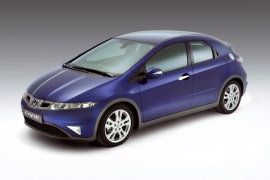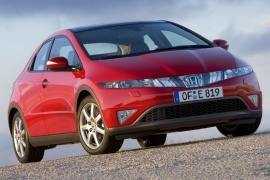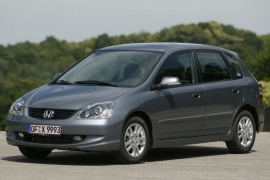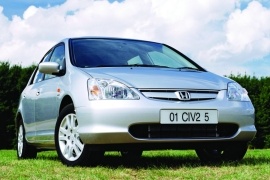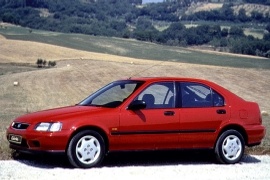HONDA Civic 5 Doors Models/Series Timeline, Specifications & Photos
First production year: 1995
Engines: Gasoline, Diesel
Body style: Hatchback
Honda unveiled the European-inspired Civic hatchback for the North-American market, and it offered more than just a new shape compared with its sedan sibling.
The Japanese carmaker had that unusual policy to offer different body versions for specific markets. For many years, it delivered a Civic Coupe in America but not in Europe and a hatchback on the Old Continent but not in the New World. Starting with the 2022 model, the carmaker changed its mind, canceled the coupe, and introduced the hatchback as a second option for the sedan version.
While the two siblings shared most of their components, they had some different design details. For instance, the hatchback featured a concave front grille with a honeycomb pattern. The lower bumper design showed a broad, A-shaped grille, similar to the one installed on the sedan version. While both cars sported the same design, the hatchback had round fog lights instead of squared ones. From its profile, the five-door version featured black side sills, which made the car looks slimmer, but the most noticeable difference was in the back. Honda designed treated the vehicle with European ingredients, and its designers took their inspiration from there. Thus, the raked-forward C-pillars and the tailgate formed a sloped, Kammback-style ending. The rear bumper was completely different, and it sported two chromed, fake exhausts and a diffuser.
The interior featured an unusual honeycomb pattern on the dashboard. Honda never did that before, and it was a bold move from the Japanese carmaker. It installed a standard 7” touch-screen on top of the center stack with physical turning knobs for volume and tuning/selection. As an option, it provided a 9” display for the Sport Touring trim level. Inside the instrument cluster, the Civic hatchback offered a seven-inch color display and an analog speedometer, or a completely digital 10.2” TFT for the full-spec version. The carmaker installed a 60/40 split-folding bench at the back, which provided a larger trunk than the sedan.
Honda installed the same powerplants as in the sedan version: a 1.5-liter turbocharged and a naturally aspirated 2.0-liter. The carmaker paired both engines with a CVT transmission but added an option for a six-speed manual.
Honda refreshed the tenth-generation Civic lineup in 2019, just two years after the model's introduction on the market, and besides fixing some technical issues, it added some changes.
The car looked like it had gone through a tuning shop right from the start, even though it was completely stock. But Honda went even further when it refreshed the car in 2019 for the 2020 model-year, a year marked by the world pandemic with several production halts and logistics issues.
At the front, the car received new body-colored slats in the foglights clusters and an updated "wing" cross-bar. In addition, its headlights received a blackout treatment, while the Sport Touring trim level added LED headlights. Moreover, the door mirrors sported a black lower part. Last but not least, the carmaker added new options for the light-alloy wheels.
Inside, the most significant change was the return of the volume turning knob. Its users criticized the car since the 2017 model-year featured only a touch scale for adjusting the volume. Moreover, the infotainment unit was upgraded with Android Auto and Apple CarPlay integration. Honda noticed that the customers were concerned about sound quality. So, even though it had to add some weight, it added more sound-deadening materials on the floor, trunk, and wheel fenders. The vehicles fitted with a dual-zone climate control received physical buttons for fan speed.
For the drivetrain, Honda kept the same 1.5-liter turbocharged gasoline engines and offered a six-speed manual for the Sport Touring trim level. Starting with the 2020 model-year, the carmaker said that it fixed the oil-dilution problem that affected many cars built before. Last but not least, the electric parking brake received an indicator light.
The Civic model has been around since 1972 and could be considered one of the most reliable cars on the market.
It’s hard to say anything bad about the new Civic, because it offered so much versatility with the comfortable and roomy interior, high quality materials, power and performance.
It was a great car for both town driving and motorways. The 2017 Civic was offered as a sedan, a coupe or a hatchback.
The hatchback version came in three available trim levels: Sport, Sport Touring and Type R.
The Sport trim level came with 18-inch alloys, foglights, a leather-wrapped steering wheel and shift knob, as well as a 5-inch central display screen, a rearview camera, Bluetooth connectivity and a 4-speaker audio system with an USB port.
The Sport Touring came with more features for a more comfortable ride, including LED headlights, automatic wipers, heated seats and an upgraded sound system. The safety package included with the Sport Touring trim level added adaptive cruise control, lane departure warning, forward collision braking with automatic emergency braking and lane departure intervention.
In Type R specifications, the Civic wwas at one point the most powerful FWD hot hatch, with its 2.0-liter 4-cylinder engine developing 306 hp. The exterior design was improved with the 20-inch wheels, a big rear wing, adaptive dampers, as well as a specific interior styling. The engine was mated with a 6-speed manual transmission only.
The ninth generation of the European Honda Civic was on its last stint and tried to remain convincing on a market that was eager to get a new compact hatchback.
Honda was almost ready to launch the tenth Civic generation, but since it wasn't the right time, they kept the ninth generation on the assembly line for another year, with some changes here and there to make it look more attractive.
The alien-looking Civic featured new LED daytime running lights at the front, which were quite scary to see them in the dark. The front bumper was also redesigned and looked sleeker than on the non-facelifted version. Its side skirts and rear bumper got a more aerodynamic design while the rear spoiler sported a black color. One of the most important upgrades was for the taillights, which received LED lamps.
Inside, Honda matched the infotainment unit with the car's look and installed an Android-Auto-based unit on the center stack. It offered the Honda-Connect ability and provided better connectivity while on the road. For selected countries, the system provided over-the-air updated traffic information.
Under the hood, the Civic kept the same engines as before: a 1.6-liter turbo-diesel and a 1.8-liter gasoline engine were the only options, apart from the ferocious turbocharged 2.0-liter for the TypeR model.
The ninth generation of the Honda Civic came with a shocking design, inspired by the manga cartoons. It featured more parts from the eighth generation, including engines and transmissions.
The 2006 Honda was the car that helped the Japanese brand to boost its sales. It was a car that attracted more customers for the brand due to its unusual, bold, design. For the 2012 model, the designers went further, with a radical look.
The aggressive headlights and reshaped grille with a lip on its lower part. While the overall shape of the car remained almost the same, all the body panels were changed. The car was aerodynamically enhanced, to increase the fuel-efficiency. The very raked A-pillars and the arched roofline had their contribution to decreasing the drag coefficient. On top of that, two small fins were glued to the rear quarter panels to decrease the rear turbulence. A novelty was for the rear doors that could have been opened at 90 degrees, allowing much better access for the rear seats.
Inside, there was a new dashboard that featured almost the same layout as its predecessor, but with a cleaner look. The divided instrument panel with the speedometer on top and the tachometer on the bottom part was kept. The seats were changed when compared with the previous generation. The high seating driver position was the same, due to the placement of the gas tank under its seat. The rear seats kept the “Magic seats” system, that allowed a folding and lifting them to increase the already big trunk.
Under the hood, the Civic was offered with a 1.8-liter naturally aspirated engine or wit a newly developed 1.6-liter turbo-diesel.
After just two years on the market, the Civic received a mild facelift meant to solve a few technical issues and some mild changes on the outside.
The Japanese carmaker was well-known for its reliable products, and the market well received the revised five-door Civic. Its radical design attracted new buyers for Honda, while previous owners criticized the vehicle due to its rear suspension and rough ride.
While the exterior was praised, a particular part of it was not very pleasant for the customers, especially the mirror-like grille. Along with the 2008 facelift, Honda replaced-it with a chromed one that sported two squared air-intakes. The front apron's triangular air-intake shapes were found into the rear, as side exhaust tips, for the 1.8-liter and 2.2-liter versions, while the 1.4-liter unit featured plastic caps in the rear apron and a hidden exhaust behind it.
The interior was focused on the driver, with a center-stack tilted toward the driver. The instrument cluster was installed on two levels, with the speedometer on top and the tachometer and the rest of the dials in a regular cluster behind the steering wheel. There was enough room for three passengers in the back, and the "Magic Seats" system allowed the bench to be raised or lowered. The rear bench featured a 60:40 split seatback or lift.
The eighth generation of the Civic featured rear trailing arms. Most of its predecessors featured double-wishbone front suspension and multi-link in the rear. That compromise was made by Honda to provide a bigger trunk space. Honda offered the car with a choice of two gasoline and one diesel engine. The standard transmission was a 6-speed manual. A robotized 5-speed version was available for both gasoline engines, while on specific markets, Honda introduced an automatic transmission.
Honda Civic has been on the market for a few decades and it had ups and downs. But with 2005 generation, it nailed it. The market was in a fever, the customers stormed the doors. Soon it became the most sold Civic in model's history.
The exterior look was arguably the most important attribute of the car. The sharp nose with a mirror-like grille covered with clear plastic, the angular headlights, and the short hood was a shocking presence. The raked A-pillars were followed by a rounded, bubble-like greenhouse. In the rear, a horizontally split rear windscreen incorporated into the tailgate completed the overall shape. The triangular air-intake shapes in the front apron were found into the rear, as side exhaust tips.
The interior was focused on the driver, with a center-stack tilted toward the driver. The instrument cluster was installed on two levels, with the speedometer on top and the tachometer and the rest of the dials in a regular cluster behind the steering wheel. The high seating position was not so welcomed by Honda fans, but it was appreciated by the first-time buyers. In the back, there was enough room for three passengers and the Magic Seats system allowed the bench to be raised or lowered. The seatback was foldable in a split, 60:40 way.
The eighth generation of the Civic was criticized by the Honda community due to its McPherson front struts and rear trailing arms. Most of its predecessors featured double-wishbone front suspension and multi-link in the rear. That compromise was made by Honda to provide a bigger trunk space. The car was offered with a choice of two gasoline and one diesel engine. Standard transmission was a 6-speed manual. A robotized 5-speed version was offered for the 1.8-liter unit.
Honda refreshed the seventh generation of the Civic in 2003. Like before, the four body versions didn't seem to belong in the same family.
The Civic's seventh-generation was available in four shapes: sedan, 3-door hatchback, 5-door hatchback, and coupe. There was no station-wagon on the list, and the 5-door version was the family version for it, more than the sedan.
The curved, triangular headlights were swept-back over the hood and fenders. Its grille was larger than the one on the sedan, and the raked windshield was completely different than the rest of its gang. Its tall greenhouse made the car looks closer to an MPV rather than a regular hatchback. A third side window was installed behind the C-pillar, like on a station-wagon. But it was just a big-sized hatchback. Like most of the facelifted versions, the 2003 Civic 5-door featured a different set of taillights from the non-facelifted version.
Inside, the Civic offered a black front fascia. It was made from plastic, and it looked bland, even though it was very functional. For the instrument cluster, Honda installed gauges with white lettering on black dials. Apart from the base version, the other trim levels featured bucket seats at the front. The rear bench offered a
There was a choice of three engines in the Civic 3-doors. While Honda manufactured the 1.4-liter and the 1.6-liter gasoline units, the 1.7-liter diesel unit was provided by Isuzu.
Honda unveiled the seventh generation of the Civic hatchback in 2001 to answer the growing market for that type of vehicle. It was the first Civic diesel as well.
After selling more than 13 million Civics worldwide, Honda tried to expand its seventh generation with three body versions: sedan, 3- and 5-door hatchback. The latter was supposed to replace the station-wagon version from its predecessor.
With sharp angles and curved body panels, the five-door version was not the best looking car in its class. It was the reason why this version was not as successful on the market. The short hood and tall greenhouse made the car looks like it was missing a part: either a bigger rear area as a station-wagon or a trunk in a three-box style. The taillights were installed on the corners like the designers forgot to draw them and added them at the last minute.
Inside, there was a different story. The gearstick was mounted on the center stack, leaving the center console clean. The instrument cluster was the same Honda-style, easy to read and uncomplicated. The black dashboard with silver air vents was the only option. In the back, the bench was fit for up to three passengers with enough legroom and headroom but limited hip and shoulder room.
Honda was known for its rev-happy VTEC engines, and the seventh-generation offered the magnificent 2.0-liter 201 hp unit, but only for the three-door version. The 5-door received a 1.6-liter unit available in two power outputs. For diesel fans, it offered a 1.7-liter four-cylinder built by Isuzu. Since all three of them were fuel-efficient, the diesel version didn't have too many buyers.
Even if it looked almost like a facelifted version of the fifth generation, the 1997 Honda Civic was an entirely new car. It lost some features and gained some others. First, it lost the double-wishbone front suspension in favor of a McPherson strut. Secondly, the rear suspension kept the independent type solution. It was available as a three- or a five-door hatchback, a four-door sedan and a coupe. It was built in more factories, in the U.S., Japan and in Swindon, in the U.K.
As far as the powerplants go, some of the previous variants were carried over, but new versions of punchier engines appeared. Some versions for Canada were not available in the U.S., and some had even heated mirrors.
Under the hood, the most powerful version was badged as VTI and had a 1.6-liter engine that developed 160 hp. On some markets, a special version called SiR was offered with a 1.6-liter and 170 hp. The fifth Civic generation had a choice of transmissions between a 5-speed manual, a 4-speed automatic and even a CVT for the eco-version HX with the VTEC-E engine.
Performance for the VTI was matching that of a European hot-hatch, and was very well received in the U.S. The reliability of the vehicles made them a choice for the young generation, some of whom used them in street racing.
In 1995, Honda owned the Rover brand and decided to build a hatchback together for the European market. It was the sixth generation, but it wasn't the success it wants.
Rover was in a difficult position, and the Unions complained about the new Japanese management and its rules. But the brand had to survive. Both R&D departments started to work on a new project, with a different approach. The result was the right car with slow sales.
The exterior was clearly far from any Civic before due to the two-and-a-half bodywork. With its tailgate raked and a short decklid, it was far from what Honda used to build. It was more like a Peugeot 309 or Renault 19 hatchback-style than the Civic. While it was highly successful in the British market, the European customers didn't fall too much for it. It was the Japanese branded Rover 45, with Honda technology.
Inside, there was a big step up in the look and quality segments. The instrument cluster was similar to the other Honda models, but the center stack was different. It wasn't a boxy-looking one anymore. Due to its rounded edges and curved dashboard design, it was much more appealing. For the first time in the Honda Civic history, it wasn't mounted as low as before. The back's room was better due to its longer wheelbase, and the space in the trunk was considerably increased due to its sloped rear end and longer rear overhang.
Under the hood, the first Honda designed and built in the U.K. featured a wide choice of gasoline and diesel engines. The base version was fitted with a 1.4-liter unit, while the most fuel-efficient was a 1.5-liter one, which made the 2.0-diesel from Rover obsolete.
